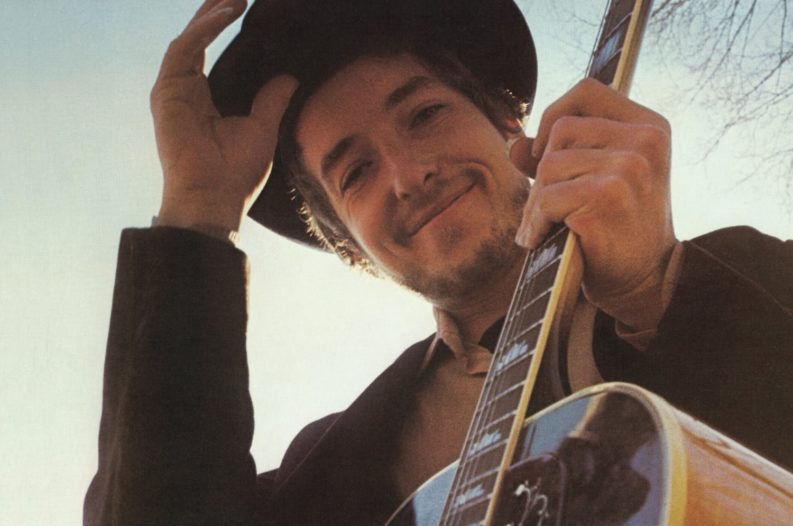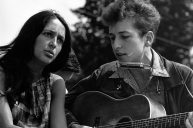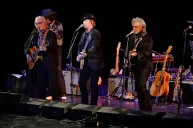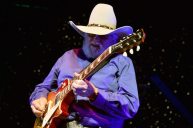Bob Dylan has always been an enigma of sorts. He's been a shape-shifting chameleon who never painted himself into a perceived corner or let anyone typecast him as a certain kind of artist. In 1969, Dylan released Nashville Skyline, his ninth studio album. It marked a change for Dylan. Instead of poetic justice, traditional folk or rambling blues, Nashville Skyline was a trim country crooner that found the troubadour as relaxed and comfortable as he's ever been.
To understand Nashville Skyline's turn, you have to look back. Like any Dylan phase or switch up, he left plenty of hints along the way. While Nashville Skyline may sound like a one-off experiment on the surface, Dylan had recorded the overwhelming majority of 1966's Blonde on Blonde and all of 1967's John Wesley Harding, his two previous albums, in Nashville. Producer Bob Johnston, who produced perhaps Dylan's greatest stretch of albums (From 1965's Highway 61 Revisited to 1970's New Morning), was again at the helm of the project.
Dylan Goes Country
While Nashville Skyline was undoubtedly Dylan's most country album, the tinges and textures had long been around. This is primarily due to Johnston's long list of session players who were at his disposal. Country session legends such as Charlie McCoy, Pete Drake, Norman Blake, Kenny Buttrey, Bob Wilson and a young Charlie Daniels would make up the backing band for the majority of the album. McCoy and Buttrey had been a part of Blonde on Blonde as well as the sparse trio who backed Dylan on John Wesley Harding — with Drake being the third musician. By the time Skyline was recorded, Dylan, Johnston, McCoy and company had grown comfortable with one another. That familiarity paid dividends. The relaxed atmosphere shines through on Skyline's silky and warm glow.
As far back as Blonde on Blonde's tracks "Visions of Johanna," "I Want You" and "4th Time Around," Dylan tries his hand at country-esque folk. By all means, much of John Wesley Harding could have easily been part of Nashville Skyline—especially album closer "I'll Be your Baby Tonight." Dylan even joked that Skyline's original title was going to be John Wesley Harding II. But there's still a distinction between the various projects, namely Dylan himself. Nashville Skyline sees Dylan ditch much of his iconic wordplay as a songsmith and adopts a smoother take on songwriting. It's here where he fully embraces a Nashvillian take. Gone is the complexity of "Sad Eyed Lady of the Lowlands" and the doomsday cataclysm of "All Along the Watchtower."
Rather, we see a simplified Dylan. On songs such as "I Threw It All Away" and "Tell Me That Isn't True," Dylan's heartache is plainspoken. On love ballads like "To Be Alone With You," the gorgeous "Lay Lady Lay" and the closing "Tonight I'll Be Staying Here With You," he does much of the same. It's a rare occurrence for Dylan. It's uncomplicated and straightforward with very little middle ground.
That in itself is why Dylan's vocals, a sugary country croon, is as delightful as it is. He's able to linger on lines that end with you, true, lay and stay. At the time, Dylan contributed his change in vocal tone as the result of quitting cigarettes. Instead of his traditional nasally jangle, Dylan's vocals are sincerely polished with a velvet touch. Had you never heard songs such as "One More Night" and "Peggy Day," you'd think of them as just another artist within The Nashville Sound. It's not quite countrypolitan, but Dylan and company do exemplify country music of the time with Skyline.
At times, Dylan tiptoes into cliche, relying too much on stereotypical country language. Even so, he offers "Country Pie," the most "Dylan-esque" effort on Skyline. Where most of the album has an "aww shucks" charm, "Country Pie" seems to have a clear wink and nod attached. He'd try to forcibly lose fans later on albums like Self Portrait and Dylan, but even here, it seems to indicate that he knows his country croon is a short-lived venture.
Superstar Collaboration
https://youtu.be/g77wH68dFC8
Still, the defining moment on Nashville Skyline is Dylan's duet with country music superstar Johnny Cash. "Girl From The North Country," originally found on Dylan's second album The Freewheelin' Bob Dylan, isn't just two icons mailing it in either. Cash and Dylan had long been mutual fans of one another's careers. The duet isn't even a one-time affair either. Cash didn't come strictly to record "Girl From The North Country."
Where the other nine songs of Skyline came from three sessions, the "Girl From The North Country" collaboration was from a session days after the others. The pair recorded 15+ songs that day and included Cash classics such as "Ring of Fire," "Big River" and "I Walk the Line" as well as Dylan's "One Too Many Mornings." Their shared admiration for early rockabilly, folk and the likes of American storytellers such as Woody Guthrie and Jimmy Rodgers propelled the session with casual and loose interpretations of traditional such as "You Are My Sunshine," "Good Old Mountain Dew" and "I Still Miss Someone." It's an insight as to where Cash and Dylan were in their careers.
They slow down the pace on "Girl From The North Country" to almost a crawl with a funeral song cadence. Unlike the rest of Skyline, it's not nearly as polished. While it's most certainly beautiful, they exchange verses and harmonize with a carefree ease built more so on raw emotion and a shared knowledge. Deep down, it's not two superstars coming together; it's two friends sharing a song.
Still, it is Dylan and Cash. But what makes the dream collaboration that much more significant is that they're joined by Tennessee Three members Marshall Grant, W.S. Holland and Bob Wootton.
Skyline's Impact & Legacy
Nashville Skyline's importance can be summed up in two main reasons: 1) helping usher in country rock to the masses and 2) reshaping the Nashville music scene.
While Skyline was certainly more of a glossy interpretation of country rock, Dylan's impact on the budding genre was as significant as the likes of country-rock godfather Gram Parsons.
Several years prior to Nashville Skyline, Dylan and The Band recorded what would become The Basement Tapes. Often bootlegged, the sessions were countryfied Dylan tunes that harkened back to a rootsier and more earthier version of country music. They wouldn't be released by Columbia Records until '75, but they were in many respects, the first hints at Dylan's country curveball.
In '68, Parsons would lead the charge of country rock with the movement's poster child album, Sweetheart of the Rodeo. That same year, The Band would release their debut album, Music From Big Pink. Both albums both heavily borrowed from Dylan in song and structure.
Read More: 10 of the Best Country Covers of Bob Dylan Songs
In total, the two albums would cover five Dylan standards: "Tears of Rage," "This Wheel's On Fire," and "I Shall Be Released" by The Band and "You Ain't Goin' Nowhere" and "Nothing Was Delivered" by The Byrds. Interestingly enough, the two albums were recorded at opposite ends of the country with Sweetheart of the Rodeo being recorded in Los Angeles while Music From Big Pink was recorded in upstate New York.
Soon thereafter, the floodgates were opened. The Parsons-led International Submarine Band's Safe at Home, Flying Burrito Brothers' The Gilded Palace of Sin, The Byrds' Ballad of Easy Rider, The Band's '69 self-titled, the Eagles' '72 debut and a host of others ushered in the new era in popular music that revolved around country accents and storytelling just as much as it did melody and groove.
While most see the rise of country-rock as being lead by the coasts, Dylan's time in Nashville is truly where the heart of the movement was located.
Nashville's Growth
Those coming of forces, Dylan and Cash, represented a coming together of music realms. While Dylan and Cash wouldn't collaborate in song ever again, the pair made a lasting impact on the dynamic makeup of what Nashville's blossoming music scene would become. It wasn't just a country music town anymore.
Singer-songwriters such as Neil Young, Leonard Cohen, John Hartford and a slew of others soon began to record in Nashville with a cast of session players that all tied back to Johnston. Often dubbed The Nashville Cats, a revolving cast of players like the aforementioned McCoy, Drake and Buttrey as well as musicians Norbert Putnam, Pig Robbins and Buddy Spicher all were paramount in Nashville's growth in diversity. Specifically, Drake's pedal steel guitar was one of the scene's most cherished aspects.
They played on a wide range of albums by the likes of country royalty like Cash, Waylon Jennings, Loretta Lynn and Tammy Wynette as well as the fledgling singer-songwriter scene that revolved around Mickey Newbury, Kris Kristofferson, Willis Alan Ramsey, Loudon Wainwright III and several others.
Skyline engineer Neil Wilburn would be a sought out production voice for years to come. His work on albums by the likes of Earl Scruggs, Johnny Winter, Michael Martin Murphey, The Byrds, as well as producing Guy Clark's first three albums further blended the once hardened lines between country, rock, folk and blues.
While these lines are almost nonexistent in today's world, in 1969, it was a much different world. Country music was often seen as a non-hip genre. It was "hillbilly music" rooted in tradition rather than experimentation and progressive growth. Nashville's industry standard at the time shunned away folk artists and rock bands like Young, The Byrds and others identified as part of the hippie counterculture.
In many respects, Skyline was the first Americana album.
Dylan, often cited the spokesperson for that movement, was criticized for Skyline since it was viewed by many as conforming towards a simplified outlook. In other words, he was "dumbing it down" for mass appeal. In reality, he was looking for another style to tackle. As a result, he sparked a different kind of revolution.




